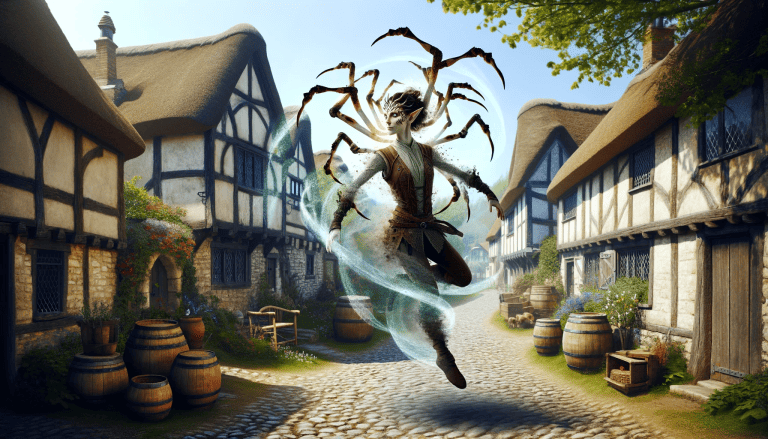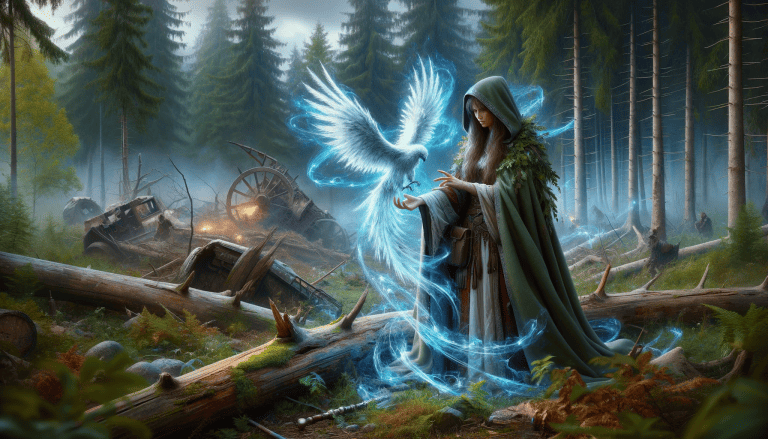How to Play Circle of Dreams Druid in 5e D&D
The Circle of Dreams was first introduced in Xanathar’s Guide to Everything, and it has often been dismissed as a Circle that isn’t worth investing much time into. Yes, it is a very situational Circle, but that doesn’t mean it’s worthless. In fact, it is greatly underrated as a healing Circle.
Every party needs someone who can save them from certain death, and Druids often find themselves designated as the party healer (especially when there isn’t a Cleric). The Circle of Dreams gives you access to some handy healing abilities that absolutely make you a valuable member of the team.
How to Use This Guide
Throughout this guide, you will see a series of emojis—we use these to rank how useful a feature or ability is for your chosen class.
✅ — A critical feature that you absolutely need in order to play your class to the best of its ability. May also provide exclusive bonuses.
🆗 — A good feature that should definitely be considered.
⚠️ — A weaker feature that might only work with specific builds. Definitely largely circumstantial.
⛔ — A terrible feature that could be detrimental to your class that often weighs you down. Can also be a dump stat that is completely useless.
How Do You Choose a Circle of Dreams Druid 5e?
The Circle of Dreams is part of what makes the Druid so interesting as a class. They might stick out a little, but at its core, this subclass is trying to bring the Druid back to its roots as a healer and great support option. You’ll spend a lot of time at the back instead of on the front line, but that’s exactly where you’ll be needed.
A lot of this Circle can feel highly situational. Still, when your abilities are needed, they’ll prove exceptionally useful to your party. But your true potential comes as you level up.
Your connection to the fey is often forgotten, but as your power increases, so will your connection. This makes you harder to pin down in combat, turns you into a master of hidden passages and secret paths, and gives you the chance to protect the party even during rest.

The Circle of Dreams and Their Connection to the Feywild
As a Circle of Dreams Druid, you have one foot in the Feywilds and the other in the Prime Material Plane. You journey between both worlds, drawing power from the Fey that allows you to become an excellent healer without sacrificing your spell slots—something other Circles don’t offer.
Your connection to the Feywild is also the reason you’re able to teleport across the battlefield as you level up. It also grants you access to secret passages that help you and your allies avoid dangerous situations.
There are nice folklore connections with this Circle as well. Your Druid is not Fey, but more of a friend to Fey, which is why you can use Fey magic and passages without negative consequences. Fey magic is known to be traditionally tricky and mischievous, but not for you.
As a Circle of Dreams Druid, you show the other side of Fey magic—the kind and nurturing side that many people never get to see because it’s so closely guarded by the Fey folk.
How to Play a Circle of Dreams Druid
Knowing how to play your class and the subclass you chose is a vital part of the game. So, how do you go about playing a Circle of Dreams Druid?
There are four vital aspects to your Circle of Dreams build:
- High Wisdom modifiers
- Knowing the basics of your build
- Selecting a race that works well with your Circle
- Choosing the right spells
Choosing a Race
The Circle of Dreams is an excellent healing and group support role, and that means you should stick with the classic Druid stat—Wisdom. However, Constitution is a good attribute to boost your durability, and Dexterity can help with your AC so you’re more resilient on the battlefield.
This is why we have three core races we recommend if you want to maximize the capability of your Circle of Dreams build. These are:
- Aarakocra
- Pallid Elf
- Hill Dwarf
Let’s take a look at these races in more detail. We don’t typically recommend Pallid Elf or Hill Dwarf for Druid subclasses, but both demonstrate a great deal of potential to maximize your Circle of Dreams build.
The Pallid Elf provides you with a +1 Wisdom and +2 Dexterity bonus to help you maximize your spellcasting and AC. The fact that they have Darkvision makes them a good scout for Hearth of Moonlight and Shadow, you get free Perception, and their Fey Ancestry makes so much sense.
Hill Dwarves can feel like a basic choice, but the +1 Wisdom and +2 Constitution bonus is no joke when improving your durability. They have immunity to poison, and the Darkvision is handy for the same reason as a Pallid Elf. Dwarven Toughness also gives you +1 HP per level for a maximum of 20, which is a massive bonus for Druids.
The Aarakocra is the classic Druid race, and it’s a great fit for the Circle of Dreams. Giving you a +1 Wisdom and +2 Dexterity bonus means better spellcasting as well as an AC boost. The fact that you can fly is infinitely useful and means your teleportation abilities don’t just work on the ground. They also work in the sky.

Knowing Your Class and Build
The Circle of Dreams is easy to skim over, especially when you read negative reactions to it online. However, it’s a build that’s full of untapped potential as a healing class. It’s all in how you build it. You won’t be needed for close combat; instead, you’ll be darting across the field as group support.
You will have a key focus on healing and teleportation magic to ensure the party stays alive and out of harm’s way. You’ll keep your weapons simple with a club or scimitar, and you’ll wear leather armor since Druids cannot wear metal. You won’t need to use weapons often, but they’re good to have handy.
Ideally, you should pick your Proficiencies in Insight, Medicine, and Perception. These allow you to take advantage of your high Wisdom score and help improve your healing capabilities. You’ll also know your own secret language, Druidic, which might come in useful during RP.
At 2nd level, you gain access to Wild Shape. This might seem pointless for a Circle of Dreams Druid, but you can utilize it in a very exciting manner. While in your Wild Shape form, “you retain any features from your class, race, or other source and can use them if the new form is physically capable of doing so.” (PHB Rules).
This means that you will get to keep any class or racial abilities (as well as abilities from other sources) when you are in Wild Shape. However, the only restriction is that your Wild Shape form must be physically capable of using these abilities.
Combine this with the fact that you can shift into a flying form at the 8th level, and nothing will compare to using Balm of the Summer Court while in Wild Shape to drop those emergency heals on the battlefield. Similarly, you can shift into a small creature and dart through battle in order to give your allies assistance.
Spells and Cantrips
While we have an entire guide dedicated to the spells and cantrips you get as a Druid, let’s take a look at some of the best ones for a Circle of Dreams Druid.
For cantrips, we suggest going with Druidcraft, Guidance, Resistance, and Produce Flame. These help to boost your role as a support for the party, giving you the opportunity to buff other members.
For 1st level spells, Healing Word is a great choice since you’re in a healing role. You may also find Detect Magic and Entangle to be helpful in terms of support and defense. At 2nd level, Summon Beast and Lesser Restoration will allow you to aid the battlefield and increase your healing capabilities.

Circle of Dreams Features
The Circle of Dreams is interesting because it lacks a strong definition, making it difficult to determine the role this Circle plays in a party. Many of its traits are also highly situational, which make things tricky for you as a spellcaster. But there’s more to this Circle than meets the eye. The nice mix of healing and utility options is part of what makes this such a tempting choice.
🆗Balm of the Summer Court (2)
What’s great is that you can use this as a bonus action to create a healing pool that allows you to rescue your party from certain death. It can be used to target creatures as far as 120 feet away, giving you incredible range when you’re in the heat of battle.
You can use several dice with this spell, keeping party members conscious and blessing them with additional temporary hit points that prevent them from dying. You can also use it in the same turn as casting a leveled spell, which is a very nice bonus indeed. Free heals and a powerful ability that can be used in Wild Shape.
⚠️Hearth of Moonlight and Shadow (6)
This can seem disappointing as a situational trait, but there’s ample opportunity to use it when adventuring. You can call on the power of the Gloaming Court to shield your party while they take a long or short rest, and everyone gets a +5 bonus to Stealth and Perception checks.
The 30ft sphere works to hide any open flames and keep your presence hidden from the outside world. However, it should be noted that it doesn’t provide cover but is instead blocked by total cover. So, make sure everyone is inside when you cast it. Tiny Hut from a Wizard trumps this, but it’s still useful to have around.
✅Hidden Paths (10)
It works as a Bonus Action that you can use several times a day, essentially making it the Druid version of Misty Step but better. You can get yourself and your allies out of dangerous situations and escape grapples by using secret Fey passageways to get around. Bonus, the teleportation works up to 60 feet.
⚠️Walker in Dreams (14)
This is a pretty handy utility option. You get to cast one of three spells for free at the end of a short rest, and it doesn’t matter if you are traveling through the Dreamlands mentally or physically. The spells are as follows:
- Dream. You use yourself as the messenger, which is great for relaying information.
- Walker in Dreams. A scrying spell for some cheeky eavesdropping.
- Teleportation Circle. It teleports you to the last place you had a long rest.

The Perfect Circle of Dreams Build
So, how do you get the perfect Circle of Dreams build? Well, we’ve mapped out our ideal build, so you’ll have a good place to start.
Stats
- ⛔ Strength: Dump stat.
- 🆗 Dexterity: Always handy to have for the added AC.
- 🆗 Constitution: A good way to boost your durability.
- ⚠️ Intelligence: Only good for knowledge skills.
- ✅ Wisdom: The most important stat.
- ⛔ Charisma: Dump stat.
Races
- ✅ Aarakocra: Offers a Wis/Dex increase as well as flight.
- ✅ Pallid Elf: Wisdom increase, Darkvision, nice Dex addition.
- ✅ Hill Dwarf: Wisdom increase, a good Con boost, and natural abilities.
Feats
- Chef: Gives the option of a Wisdom or Constitution increase. And the ability to make Treats works really well as a support for the rest of the party – especially when you’re fleeing from your enemies and only have time for a short rest to regain some Hit Points.
- Resilient: Gives you a nice Constitution Proficiency that will help increase durability.
🌿 Learn more: Guide to the best Druid feats
Skills
- Insight
- Perception
- Medicine
Spells
Cantrips:
- Create Bonfire: It’s time to keep the party warm at night while also doubling down as a nice damage dealer if you find yourself in combat.
- Guidance: Boost your party to ensure that they have an increase on skill checks.
- Resistance: Touch a willing creature. Target gains 1d4 to a saving throw of its choice.
- Shape Water. This cantrip is versatile and powerful. You get the power over the forming of objects from ice, and as a support role It gives you a solution to many problems that your party might face.
1st Level:
- Goodberry: Create delicious healing berries that restore health. A great one to use outside of battle and to have on hand for a quick top off.
- Healing Word: Heal a target you can see for 1d4. Increases your ability to heal at a range. You can further increase this with Enhanced Bond.
- Detect Magic: Detect a magic source and what type it is.
- Protection from Evil and Good: It’s a situational spell, but as the support in the party it can actually come in pretty handy when you need it.
2nd Level:
- Healing Spirit: It’s better than Cure Wounds and offers some very nice healing effects and capabilities.
- Lesser Restoration: Offers a good range of healing effects.
- Enlarge/Reduce: Boost your size and gain advantage on Strength saves and checks, and get an extra 1d4 damage to attacks. Or reduce the size of your enemy, causing a disadvantage on Strength saves and checks.

Weapons
As for weapons, it’s the same old same old for Druids in pretty much any Circle. You will need a weapon as a Circle of Dreams Druid, especially since you’ll find yourself in melee combat. These are some of the best options you’ll have:
- Sling
- Staff
- Javelin
- Scimitar
FAQs
Is Circle of Dreams Good for Healing?
The Circle of Dreams is good for healing, and it offers great benefits such as Balm of the Summer Court. It might not be the number one way to build a healer Druid, but the results are great, and it is certainly an underrated Circle.
What Book Is Circle of Dreams In?
The Circle of Dreams was first found in Xanathar’s Guide to Everything. It was brought in as a way to utilize your Druid in a manner that leans towards healing and general party support. While many of its features are highly situational, they remain very useful.
Can Circle of Dreams Druids Wild Shape?
Yes, Circle of Dreams Druids can use Wild Shape. This applies to all Druids who unlock the ability once they hit 2nd level. While they cannot use it to the same extent as a Circle of the Moon Druid, it is still useful for scouting as well as in light combat scenarios.
Is Circle of Dreams Good for Beginners?
The Circle of Dreams isn’t the best choice for beginners because of its situational nature and the fact that it can take some time and skill to master. There are definitely better options for being introduced to the Druid Circles, such as the Circle of Stars or even the Circle of the Moon.
To Sum It Up
We hope you enjoyed this guide to The Circle of Dreams, and we are excited to see if you have found new and interesting ways to utilize their healing capabilities. It might be a situational Circle, but the truth is that it’s filled with untapped potential that you are sure to benefit from. Why not show us how this guide has helped enhance your D&D adventures? Make sure you drop your experiences in the comment section below so we can share in your journey.







